continuousWave-->Whaler-->Rendezvous-->NC2000
Day One | Day Two | Day Three | Day Four
![[Logotype: Rendezvous]](graphics/nc.gif)
Classic Whaler North Channel Rendezvous 2000
Four days of Non-Stop Whalering
In the Pristine Water of Lake Huron
DAY ONE
Friday, August 4, 2000
Birmingham, Michigan to Tobermory, Ontario by Car (285 miles)
Tobermory to Little Current, Manitoulin Island by Boat (60 miles)
Driving Up
0915 It is a beautiful summer morning, and I am driving north on Interstate-94
toward Port Huron, aiming ultimately for Neptune Island in Lake Huron's
North Channel, the site of our first "North Channel Classic Whaler Rendezvous."
It has been only a few weeks since I returned from a nine-day trip to
Lake Superior, and they have been very busy days for me, but now,
as the miles roll north, I am beginning to relax and anticipate the fun of
the trip ahead.
The overpass sign on the interstate announces "Meldrum Road", and I crack
a smile, thinking about who was Meldrum that he left a bay, a town, and a
road named after him. Of course, Meldrum Bay is about 350 miles north, on
the western end of Manitoulin Island, but I wonder if it's the same fellow
who has lent his name to both.
We have been having day after day of rain the past two weeks, pouring down
practically every morning or night, but finally the weather seems to have cleared.
It is warm and there is still a slight haze in the sky, but definitely fair weather.
I glance to the east and see a tall smokestack over on the St. Clair River with
a plume rising straight up--no wind at all this morning. We have the ingredients
for great boating on Georgian Bay: sunny sky and little wind.
1030 Entering Canada at Sarnia, the Border Guard/Customs Agent just
gives me a shrug when I declare I have a 12-pack of beer in the cooler. I pull
over to exchange currency and to get a new highway map for Ontario;
I've been warned by Jim Gibson that the province has changed a few
of the highway numbers along the route to Tobermory.
1230 I take a quick break in Port Elgin for a burger. I eat with
one eye on the highway, in case I see two big Whalers go by on trailers
pulled by Cadillacs--that would be the Goltz's.
1300 North of South Hampton I get some gas for $0.719 Canadian/litre.
How much is that in U.S. Dollars per gallon? [Answer: $1.916]
Up to the Bruce
Finally, I turn north for the Bruce Peninsula. Pulling onto this final leg
of the car ride, I feel the excitement increasing.
I have been worrying about how to get up here, where to stay, whether to
haul my little 15-footer along behind, to take the ferry or cross with
the others--a lot of questions--but they're all behind me now. Ahead is
just 40 miles of straight highway with beautiful Little Tub Harbour literally
at the end of the road. The fun is about to start.
The weather is still wonderfully fair, the sky is a beautiful shade
of blue today and cloudless, but I can see a breeze in the trees.
And I'm far inland at the moment, so that is
not a good sign.
1350 A highway sign cues me to listen on the AM radio for re-transmission
of the marine weather information. What a nice service to have available.
The broadcast contains generally good news:
PRECIPITATION PROBABILITIES
Tonight 0 %
Saturday 0 %
Sunday 30 %
WINDS: NorthWest at fifteen to twenty knots, diminishing to
ten to fifteen knots tonight.
OUTLOOK: Moderate Southwesterlies increasing to Strong Southerly
You have to love those first two numbers; there'll not be any rain
on the start of this weekend. But the wind forecast is chilling. You
don't really want to head north across Georgian Bay into 15-20 knot
headwinds. That could be a problem for boats of the size we are
going to be using.
Little Tub Harbour
1355 I have spotted Jim Gibson's Boston
Whaler 19 Outrage-II, but I don't see the note he left on the windshield
telling me he'll be back at 2:00 p.m. I walk around the harbour,
looking at boats, and strike up a conversation with a fellow that
just came south from Manitoulin in a 30-foot trawler style boat.
He says it was a rough crossing for them.
Looking around the harbour, the breeze is evident. It is blowing
about 20 knots from the west,
making all the flags stand out straight and snap a bit,
but, if I can judge from this perspective, it looks like there is a hint
of a southerly component to it. That would be a blessing. I rationalize
to myself that we're on the tip of a 75-mile peninsula, so naturally
the wind is going to be funneling through here. Maybe the lake breeze
will be lighter.
1405 From the end of the pier I look out to see a 21-foot Whaler
coming into the harbour--it's BACKLASH with Steve and Carolyn Farnsworth
aboard, along with Jim. I meet them all for the first time in person. They've been
in contact with Larry Goltz by cellular telephone, and he's about an hour
away, still coming north on the highway.
As BACKLASH rafts up along side of MEMORY, the first
thing I notice about these two Whalers is they are in immalculate condition.
I mean they look better than the Boat Show! These boats are spotlessly
clean, and all the rigging is beautifully done. The smallest detail is
executed flawlessly.
After the raft-up is secured, Carolyn breaks out a mop and swabs the
foredeck of the 21-Walk Around.
Wow, these folks are serious about their boats.
Now there is the problem of all my gear and where to stow it. I am going
to be riding up with Jim Gibson, so naturally it makes sense to put it onboard
his boat. You'd think that on a 19-foot boat that already has one person's
gear for a four-day live-aboard cruise that you would be running short of places
to stow another complete complement of the same stuff. But Jim keeps opening
lockers and throwing stuff in, and except for a couple of canvas bags
with groceries for the Rendezvous that we lash to the seat in front of
the console, all my stuff goes somewhere in the boat without a problem.
Amazing! We even get that 12-pack of Labatt's Blue on ice.
The Goltz's Arrive
1530 After two days on the road, the Goltz's car and boat carravan is about to arrive.
First, Larry's son Larry (LCG) backs their 18-foot Outrage T/T WHALE LURE
down the ramp. It rolls off the trailer in a flash. Steve and Jim warp
the boat around the end of the launching pier, Larry drives the trailer
up the street to the huge parking lot at the Royal Canadian Legion Post,
I snap a few pictures,
and we're standing-by for our next arrival.
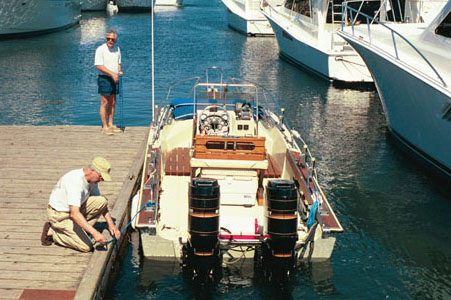 |
T/T WHALE LURE
The courtesy dock at the launching ramp at Tobermory
temporarily holds the Goltz Whaler 18-Outrage.
Jim Gibson (foreground) and Steve Farnsworth make
fast the dock lines. Note that nice teak platform
in the bow, which creates a big level deck for use
as a sleeping compartment under the forward shelter canvas.
It's Larry Goltz custom designed and built, and the construction
is yacht joinery quality.
|
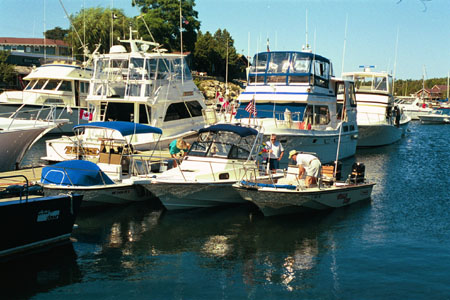 |
Little Tub Harbour
These Boston Whalers were a bit smaller than most of
the powerboats that cruise the waters of Georgian Bay.
|
I am admiring the immaculate condition of T/T WHALE LURE when Larry (LCG) returns from
the parking lot, and I comment to him about how great the wood looks.
"It should," he replies, "Larry's
been staying up until four o'clock every night for the past two weeks
working on it!"
Then Larry (LCG) hops aboard the Outrage and begins wiping down
the twin black Mercury 115-HP outboards with a polishing cloth.
"Man," he says, "I've gotta get this road dust and grime off these
engines."
So that is how you get these Whalers looking this good.
While his son has been launching the "tender", Larry Goltz has
been gassing up WHALE LURE on the highway. He doesn't
like to tow with a full tank of gas on board, as that adds a considerable
amount of weight to the already heavy trailer load. Soon, the big
25-foot Outrage comes around the corner and down to the ramp.
It is quite a sight, the big boat towering over the long, low tow vehicle,
another Cadillac Fleetwood Brougham. "It's a Cadillac with
a Suburban chassis," says Larry. It is rated for 7,000 pounds of trailer.
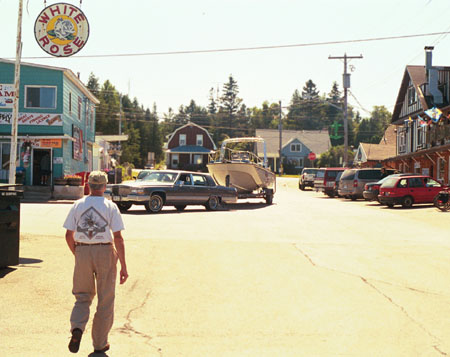 |
Whaler in Tow
A Cadillac Fleetwood Brougham sedan brings a big Boston Whaler to the
launch ramp at Tobermory.
|
The launching ramp basically bisects the "downtown" area of the village
of Tobermory, and the big Cadillac and the big boat with twin 200-HP black Mercury outboards
hanging off the stern bracket attracts a lot of attention from
pedestrians criscrossing the ramp behind it. It's the Friday of a three-day
holiday weekend in Canada, and the little town is very busy and crowded.
We stop traffic for a minute to back the boat into the water.
Larry (LCG) hops aboard the big boat as his dad (LHG) backs the
rig down the ramp. To provide a little safety margin,
Larry actually has the car's transmission in DRIVE while the
weight of the boat pulls the rig down the ramp as he
gently eases off the brakes. Once the engines are in the water, Larry starts them
up. With almost 4,500 pounds of boat and engines trying to roll off the
trailer, there is too much tension on the strap hook to release it from
the boat, and rather than let it unroll, Larry (LCG) gives the boat
a little forward thrust so Larry (LHG) can release the bow strap.
Once undone, the boat rolls off the trailer on its own and into Lake Huron.
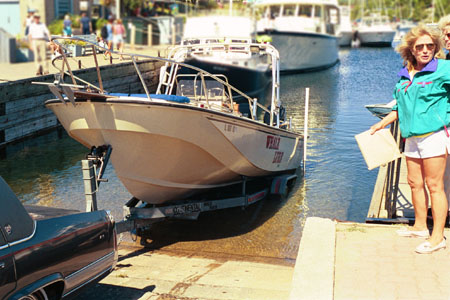 |
Putting Keel Rollers To The Test
With the rear wheels of the trailer hardly wet,
4,500 pounds of Boston Whaler (plus 900 pounds of fuel)
are ready to roll down into the clear water of Little Tub Harbour.
It was a thing of beauty to see how
easy it was to launch this big boat.
Carolyn Farnsworth directs street traffic.
|
The Crossing
![[Map of Courseline]](images/courseLineDayOne200x500.gif)
Since
I've made this trip a couple of times before, I am by default
elected Navigator for the fleet. "Here's the plan," I announce. "We'll
head out to the end of Cove Island, work our way north, coming
up the eastern side of Fitzwilliam Island, and trying to stay along
the eastern shore of Manitoulin, where we might find a bit of a lee."
I guess everyone trusts me, as there is no dissent. It just takes the
Goltz's a minute to toss all their gear aboard the two Whalers, and then
everyone is ready to go. North to Manitoulin!
LEG ONE: Tobermory to Cove Island
5 Miles
1630 We depart Little Tub Harbour, Tobermory, Ontario, and head
out for the open water of Georgian Bay. I have to confess that it has been
over ten years since I left Tobermory Harbour in a boat of my own, and the
view from water level is not really etched in my memory. As we turn the corner
at the harbour entrance, I am studying the chart and trying to correlate
what I am seeing on the water to what I see on the Chart.
"OKay," I say to Jim GIbson at the helm, "that's Russell Island there
(pointing)."
"Actually, responds Jim who has just been out in this water a few
minutes ago aboard BACKLASH, "I think that's Flowerpot Island."
Wow, my confidence is shaken. Have I gotten this confused just 100 yards
out of the harbour? I take several quick glances at the chart and the land
forms we are seeing. I look over Jim's shoulder at the compass to check
our heading. No, I decide, that has got to be Russell Island. A few more
moments and we clear the other tip of the peninsula, and Flowerpot Island
(to the east of us) comes into view.
"There's Flowerpot over there," I point, and Jim agrees. My confidence
in my own navigation returns.
Our four-boat flotilla assembles and charges along in the shelter
provided by Cove Island. The lake swell is rolling up on us, but it
is attenuated by the land intervening. It will be the calmest water
we'll see for several hours. I snap the last of the pictures, and stow
the camera.
![[Photo: Leaving Tobermory]](images/leaveTobermory512x341.jpeg) |
Leaving Tobermory
Heading northwest from Tobermory, we leave Echo Island to starboard.
We are still in the lee of Cove Island, protecting us from the big
swell rolling up Lake Huron from the west-southwest.
|
"Once we get to Cove Island Light, we'll be in open water
and we'll see how rough it is going to be," I announce. "But then we'll
turn and go more north and downwind."
Catching you up on the wind and waves, we have found--to my delight--
that indeed there is some southerly component to them, and the wind,
which has been pushed southward by the bulk of Manitoulin Island,
is generally bending back to the north, and in the process
giving us just enough of a downwind direction that we will be going
across or with the waves and not against them. But they're still
big waves for 18-foot boats.
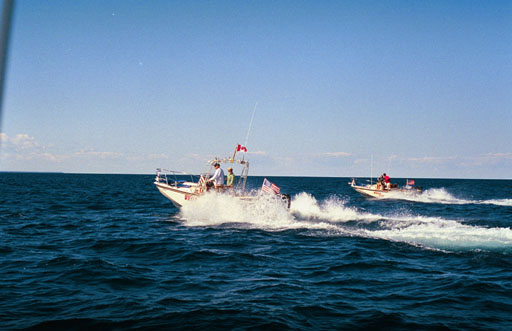 |
Georgian Bay Open Water
On the horizon to the left is the headland of Fitzwilliam Island,
about fourteen miles away. This is the last picture
on this leg; after this it's hang on with both hands.
The waves are averaging about three to four feet, with an
occasional six-footer thrown in to keep you on your toes,
but we manage to keep the boats up
on plane for most of the trip.
|
We slow down to idle just north of the beautiful Imperial Tower of
Cove Island Light, and let the flotilla reassemble. The waves are bigger
but we take them at a better angle when we turn north. The Farnsworth's
on BACKLASH, the 21-Walk Around, have had no problem keeping up,
but the two Outrages are a little behind. We let them catch up. Lynn's
son Patrick is on the 18-foot boat, and the ride has been a little rough
for him so they've had to slow down.
LEG TWO: Cove Island to Rabbit Island
17 Miles
We've finished LEG ONE of the trip, the five miles out to Cove Island,
and now we head for Rabbit Island, about 17 miles due north of us.
We take the lead again, and Jim gets MEMORY back on plane. We can
make about 25 MPH or so, bouncing across the wave tops, but the ride is
a bit rough.
We catch some calmer water as we get behind Fitzwilliam Island, and
the break is appreciated. But, again, the flotilla has stretched out
to about a mile apart, so we slow down and wait for the others to catch
up. We guess the source of the delay might be a bit of a mutiny on
the 18-foot Outrage. The ride is rough, even for an old salt,
so it might be getting to be too much for someone on his first league
out from land.
North of Wall Island, instead of finding a lee along the big island,
it almost seems like the wind is roaring up the channel between Fitzwilliam
and Manitoulin, and the seas that come with it are as big as ever.
Thankfully, they are headed north along with us.
By the time we approach Rabbit Island, I am getting a little weary
of the pounding myself. I diplomatically ask Jim if I might take a turn
at the helm. Jim, the absolute perfect gentleman, of course assents to
my request. The first thing I do is slow down a little! I back it down
from 22-24 MPH to more like 18-20 MPH, and I think the ride improves
a bit. I also get to put more of my butt on the leaning post, which helps.
And over many years of boating I have always found that being the
helmsman makes the ride easier to tolerate. There is something
psychological about having your hands on the wheel and throttle
that takes a little roughness out of the ride. LEG TWO of the trip
is now behind us.
LEG THREE: Rabbit Island to Cape Smith
11 Miles
Next target is Cape Smith, about 11 miles ahead.
I cozy in toward shore, which consists
of big clay cliffs along Manitoulin. I think the waves a bit smaller in here,
but the others hang out about a half-mile off shore. Soon we are abeam
"The Nest" and then leaving Cape Smith in our wake. I am getting
acquainted with how this boat handles, and it is a a pleasure to
drive it northward. We have to stop again to
let the stragglers catch up. I check the navigation on these pauses,
as it is too rough to focus on the chart while running.
![[Photo: Leaving Tobermory]](images/memoryGeorgianBay512x289.jpeg) |
Georgian Bay
Your author at the helm of MEMORY north of
Rabbit Island in Georgian Bay. I often wear my PFD both
for safety and comfort. It keeps me warm and acts as a flak
jacket when you get tossed around the boat.
Georgian "Bay" is a bit of a misnomer.
It is essentially the sixth Great Lake,
encompassing a body of water that stretches 100 miles north to
south, and almost that distance east and west.
PhotoCredit: LHG
|
LEG FOUR: Cape Smith to Lansdowne Channel
15 Miles
So far the winds have been contrary to the predicted northwest 15-20,
and that has been to our benefit. The island bulk of Manitoulin
(it is 40 miles wide on the eastern end) tends to separate
the westerly winds into two streams, one going to the
south of the island and one going to the north.
Although the wind has been a touch out of the south of west on our trip
up the eastern shore, as we approach the northern side of the island
it is about to switch on us.
Somewhere north of the big flashing buoy on Campbell Rock, the
wind begins to haul to the north. As we approach Burnt Island Bank,
the westerly is really howling down the North Channel and right in
our faces. We chug across the open water at a slow, bow up trim,
rounding the SW tip of Badgeley Island and ducking into the shelter
of the Lansdowne Channel. Compared to the six-foot white caps we
just left outside, the water in here is like glass.
After bringing up the rear on the whole trip so far, Larry (LCG)
on the 18-Outrage has some steam to vent. He and Patrick go past
us in a blur, heading up the channel and into a setting sun that makes
seeing ahead a problem. (Later we hear that they were going about
62 MPH at that point.) "Boy," I say to Jim, "I hope he sees those
buoys up there (that mark a couple of shoals ahead)."
LEG FIVE: Frazier Bay to Little Current
10 Miles
We enjoy about four miles of calm water in the Lansdowne Channel,
then it is back to open water. Even Heywood Island is not much of a
shelter from the big westerly, and from here on it is all directly upwind
to Little Current. It is getting late in the day, and we have the
northern lattitude, the mid-summer date, and daylight savings time
to thank for the very late sunset. The upper limb of the sun won't
disappear until after 8:30 p.m., and there will be twilight for a half an
hour after that.
We round the point on the north tip of Strawberry Island, still quaint
with its small white lighthouse and red roof, and then we are on the
home stretch for Little Current.
The high-tension towers that carry the power across the narrows to
the island loom in the distance ahead. We are close to the end of our
crossing, sixty miles or more of water under the keels. We head up the buoyed
channel into the narrows at the swinging bridge. There is quite a rip
of current flowing under it, pushed on by the strong westerly breeze,
but it is no match for our fleet of Whalers. In a few minutes we are
past the bridge, and idling through the NO-WAKE zone toward Spider
Bay Marina, just west of Little Current.
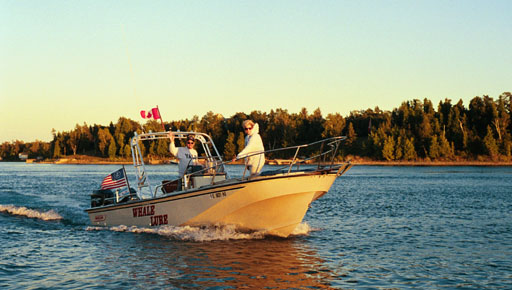 |
Approaching Little Current
You can see by the angle of the sun that we are arriving
in Little Current rather late in the day. We were fast to the
marina pier about eight-thirty that evening, just beating
the sunset.
|
Spider Bay Marina
At Spider Bay Marina, operated by the town of Little Current,
we're directed to the last (and most shallow) row of
slips--I think they've underestimated the size and draft of some of these
Boston Whalers, thinking them all little outboard boats. We get everyone
into their assigned slip and tied up for the night just as the sun sets
below the horizon. Jim Gibson
tosses me a Labatt's from the cooler; after the long trip it tastes
especially good.
Coming on to almost nine o'clock, I call the Shaftesbury Inn to make sure they still
have a room for me. "Yes, the innkeeper says, "you are in room number nine,
I'll leave the door open for you and see you in the morning." I drag my
duffel bag and other gear off the boat and head up the hill to the lodging.
I'll meet the rest of the gang in town for dinner.
Dinner
Despite it being a big holiday weekend, downtown Little Current is almost shut
down by 9:00 p.m. this Friday night, and the only restaurant left open for
us is the infamous ANCHOR INN, more of a tavern than an eatery.
We're all hungry, but we've lost a few of the gang. Dinner is attended
by Larry Goltz (LHG), Lynn, Patrick (her son), Jim Gibson, and me.
The modestly priced WHITEFISH SPECIAL ($9.50 Canadian) is the most
popular choice, and the enhanced hunger after a long afternoon on the water
provides a valuable adjunct to the actual taste.
Larry gets an introduction to fresh produce up here in the hinterlands of
Ontario. "Look at that potato," he says as he jabs his baked offering,
"it's gross!" As I said, the ANCHOR INN's reputation
is based more on its drinks than its meals.
Shaftesbury Inn
Sometime after ten o'clock, we part company for the night,
most heading back to sleep aboard in the marina, while I return to the
Shaftesbury Inn for the night. I am kind of sad to watch everyone else
trek down the road to the marina, while I walk alone up the hill.
We've really had a fun day together, enjoyed a meal and conversation,
and it's a shame it has to end, but it's almost eleven o'clock,
and everyone is tired.
The Shaftesbury, the oldest inn on the island, takes its name from
the early name for the town that since became Little Current.
It holds plenty of good memories for me, as I had my first meal on Manitoulin
in its dining room back in 1986. Since then it closed down, was sold, was completely
renovated, and reopened just a few years ago. It turns out I am provided with
a nice suite of rooms, a bedroom, a sitting room and a large bath. The
accomodations are nice, and the evening suited for sleeping, with
a fresh breeze cooling off the room and making the temperature perfect
for sleeping. After a long day of travel by car, boat, and foot, I have
no trouble getting to sleep. Day One of the Rendezvous has been a great
success!
Boating Retrospective
Looking back on this part of the trip, it is really quite amazing.
We took four outboard powered boats, just 18, 19, 21, and 25-feet long,
across 60 miles of rough water, and everyone's boat ran perfectly.
No problems, no breakdowns, no engine trouble. Nothing came loose or broke.
Those grocery bags that Jim lashed into the front cooler seat ahead of the
console were just as dry and upright as the moment they were loaded on.
All my stowed gear came out of the lockers dry as a bone. I think you would
be hard pressed to find four other outboard boats of comparable size that
could make this crossing as easily. It was really an eye-opener for me
to see the ability of the Boston Whaler to stand up to rough conditions,
and testimony to the excellent condition that these boats are maintained in.
The narrative continues with Day Two.
What follows are some observations about the boat I've been riding on today,
Jim Gibson's beautiful MEMORY.
The 19-Foot Outrage-II
The 1992 19-foot Outrage-II is actually the newest boat in our little fleet
today. It is making a very favorable impression on me as it handles
this big open water with relative ease.
I cannot imagine saying that about too many other boats of the same size
and weight.
MEMORY is similar to the Classic Outrage
center console open boat, but there are a few changes.
Most prominent is the taller center console, including a high
tinted windshield that actually provides good shelter from
the wind when standing. A sturdy stainless steel grab rail surrounds
the plexi-glass, and it is very handy to have that available today.
The helm position seating is a leaning post,
which I find to be comfortable, especially for the helmsman,
who takes the center half of the seat. Jim has rigged a foot rest on the
console that lets you lean/sit in just the right position when at the helm.
Like all center console boats, the best seat is for the helmsman
and everyone else's perch is a notch down.
I am standing on the starboard side of the console, and that is for a couple of
reasons. First, the boat tends to lean into the wind, which is from the port side today,
so my 225 pounds are helping to even the trim. Also, I get more lee from the
wind and spray over there. I find the best position for me is to stand
and lean my butt on a corner of the leaning post, hanging on to a well-placed grab rail
on the console with one hand,
and to the sturdy Bimini support frame, too, on occassions with other.
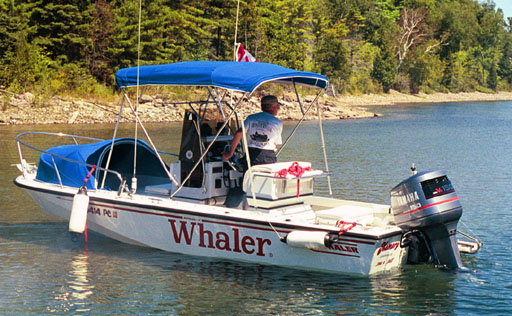 |
1992 19 Outrage-II
Jim Gibson manuevers MEMORY in the shoal water
along the south shore of Neptune Island. The taller center
console and narrower motor well are the two biggest changes
from the earlier Outrage design. This is a wonderfully
equipped and immaculately maintained boat.
|
Forward of the console there is a cooler seat, but we have a couple large
canvas bags of groceries lashed into it. I think the ride would be awfully
hard today if you tried to sit there. The cooler is used more for storage
than refrigeration, and it swallows up a lot of gear. In the bow there
are big lockers under the cushioned sitting area, and these are also full
of equipment and gear, as well as ground tackle, although Jim has a
light weight Danforth style anchor stowed on the bow roller.
Under the leaning post seat is another big storage
area, and Jim has this carefully organized and filled to the brim with
spares, tools, and other equipment. And the leaning post cushion
top itself hinges open to reveal even more storage.
In the console there are some lockers, and we stow my navigation kit
and camera in there. It's amazing all the
places there are in this boat to put things.
At the stern there are two covered wells in each corner.
Jim uses the port well as a wet cooler, keeping our
Labatts cold, while the starboard well is dry and used for storage.
There is also another cooler/seat, and this one is used to keep
food and groceries cold. You could sit on top of the cooler, or
in the little quarter-seats with flip-up backrests.
In all, this boat has an amazing amount of well planned and organized
storage and seating. There's a place for everything and everyone.
One significant difference with this newer style Outrage-II is the
construction of the deck liner mold. Beginning
with the first Boston Whaler, the boats have always been made
with two molded assemblies, formed in a hull mold and a deck mold,
which are clamped together and filled with dense foam.
Most details of the cockpit are molded into the deck mold,
but several wells or cavities are included, which in the finished
boat are then covered with additional molded floor pieces that
are mechanically fastened and caulked in place.
With the Outrage-II, a new technique has been used.
The hull is first joined with a second assembly that does not
have all the cockpit components molded into it; it is just a simple inner liner.
The foam is introduced between these two assemblies, creating the traditional
Boston Whaler "Uni-Bond" construction.
Then, a third molded assembly that contains all the details
and components of the deck--the lockers, the console base, and the
seats--is over laid and bonded to the boat, joining the hull/liner component
at the rub rail line. This forms the interior of the boat as
a seamless, one-piece structure. It also adds additional weight,
and the Outrage-II weighs about 650 pounds more than the classic Outrage
of the same size.
Having a one-piece seamless molded deck is an advantage and a disadvantage.
Without caulked joints to other components, the deck is easier to
keep clean. Dirt does not accumulate in the caulk, as it
always tends to do. Water cannot penetrate to interior cavities,
although it can collect in the bottom of molded lockers or sumps.
And the floor sheds water beautifully, flowing aft in seconds and
into the sump for draining or pumping overboard.
But the one-piece deck also completely encapsulates the embedded fuel tank. Should the tank develop a problem, the boat would likely have to be sent back to the factory for repairs. There is no way to access
the fuel tank short of cutting a huge section of the deck away.
Accordingly, Jim Gibson is fastidious about keeping the tank full and
free from accumulated water.
The boat is powered by a 150-HP single Yamaha outboard. This makes
for a very responsive boat. Of course during this ride we'll never
get a chance to run full-throttle, but the engine seems to have plenty
of power, and can get the boat right up on plane without digging a
hole in the stern on the way. The big Yamaha V-6 also shows good
performance at lower speeds, as it holds the boat on a slow plane
at around 18-20 MPH without trying to hunt for faster RPM.
This was one very marked difference from my old 50-HP Mercury,
which seems like it always wants to accellerate to about 4000 RPM,
or lug down to about 2200 RPM, but won't stay anywhere in between.
The 150-HP Yamaha stayed at whatever RPM you set it to, and had enough
power and torque at lower speeds to keep the boat going. There's
a four-blade stainless prop and no Doel-Fin on the lower unit. The engine
looks like it is the same size as the 200-HP V-6 on the Farnsworth's boat,
so perhaps this is the big engine "de-tuned". It runs very well, and
it has a quiet sound, at certain speeds sounding more like a big electric
motor than an internal combustion 2-stroke.
The transom design is one marked change from the earlier Outrages:
it is only wide enough for one engine. This has become part of the
post-Dougherty design philosophy at Boston Whaler. The transoms of
the smaller boats are not designed for twin-engines any more. You
have to move up to 23-feet or longer to have room on the back
for twins. Perhaps some of the reasoning behind that is the availability
of large horsepower outboards. With 200-HP (or more) from a single
engine no longer an exotic species, there is some rationale for
going with one engine. And reclaiming all the transom space for
seating and storage is a plus. It also makes it possible to
have a permanently mounted swim ladder on the stern, which
is a handy addition if you ever want to get back into the boat
from the water. Of course, having twin engines does
have a certain panache, not to mention the redundancy factor.
But we're out in the middle of Georgian Bay today and I don't really
feel too worried about the single engine factor, not the way the
boat is performing right now.
It is really impressive how this "19" foot boat is handling the
waves. We are clipping right along, on plane most of the time, and
I don't have any sense at all that the boat is taking a beating.
When we were back in Tobermory and Jim
suggested we put the canvas bags of groceries on the front cooler seat,
I have to confess that I thought to myself that these would be spilled
all over the boat in no time! But we're more than halfway across now
and those bags are exactly where we set them; they haven't budged.
Oh, we've come off some big waves and hit a little hard, but the
totally solid Whaler hull construction has just shrugged that off
and kept going. We're not serving tea and watercress sandwiches
in these seas, but we are going to make to Little Current without
a problem.
The controls at the helm are very nicely laid out. The steering wheel
presents at about a 45-degree angle, and of course it's a classic
stainless steel spoked wheel. For me, the more vertical the wheel
the better, and this one feels good. The engine control is binacle mounted,
and lands just about right you'd want it to be. The controls are Yamaha,
and seem to work fine.
Jim has installed a APELCO combination GPS and sounder,
so all your naviation data is presented on a single large screen.
You get the usual heading, speed, LAT and LON, as well as depth.
The engine gauges include a TACH and [help!].
There's a VHF Marine radio, too, and a nice big compass.
The attention to detail on this boat is wonderful. Jim seems to have
anticipated every need and provided a solution. When some dirt gets on the
deck, out comes a little coiled hose and nozzle gadget that plugs into
an obscure fitting on the leaning post base, and you've got a raw water
wash down. Need fenders? They're in their spot under the console, ready
to hang on the railings.
Jim's 19 Outrage-II is equipped with
some very nice canvas, including a forward shelter that cuts down a lot of
wind and creates a sleeping cabin in the bow.
He also has a large bimini top, side curtains, and windshield filler,
although we are running without the curtains or windshield in place.
The tall console plexi-glas windshield is providing enough shelter from the wind,
although if it were raining we'd want the curtains up right away.
There is also a large drop curtain for the aft side of the bimini,
making it possible to completely enclose the forward three-forths of the boat.
The clear curtain areas of the rig also have roll down canvas privacy backing
panels, making it possible to create an enclosed private cabin
for overnighting.
At the time of this boat's manufacture, Mills & Co. canvas was
not available as the factory canvas.
The hull color of this era Whaler is a pure white gelcoat, but the
interior liner and components are done in a slightly grayer shade.
The change is subtle, and I didn't notice it at first. In fact,
I only discovered it when looking at it with another all-white
boat alongside. As previously mentioned, this boat is spotless
and in immaculate condition--better than you'd see at the dealer or
the boat show, really. If you're coming to a rendezvous with these guys,
you'll want to make sure you've got your boat looking good.
The narrative continues with Day Two.
continuousWave-->Whaler-->Rendezvous-->NC2000
Day One | Day Two | Day Three | Day Four
Copyright © 1999, 2000 by James W. Hebert. Unauthorized reproduction prohibited!
This is a verified HTML 4.0 document served to you from continuousWave
URI: http://continuouswave.com
Last modified:
Author: James W. Hebert

![[Logotype: Rendezvous]](graphics/nc.gif)



![[Map of Courseline]](images/courseLineDayOne200x500.gif)
![[Photo: Leaving Tobermory]](images/leaveTobermory512x341.jpeg)

![[Photo: Leaving Tobermory]](images/memoryGeorgianBay512x289.jpeg)

